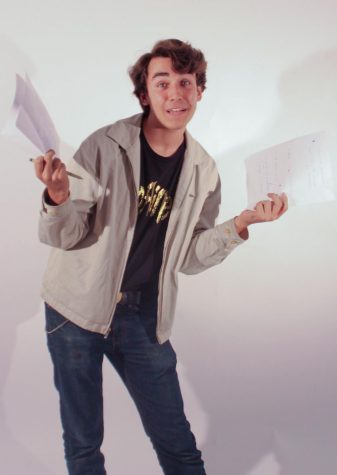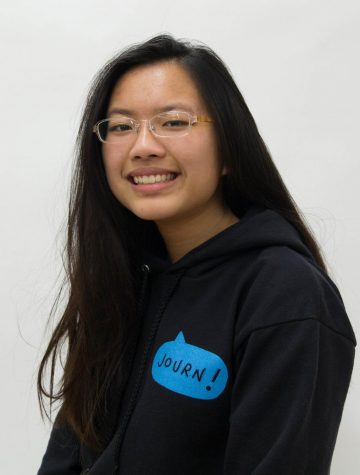What is a creator? We explore four Lowell students’ unique creative endeavors
From left to right: Junior Ellie Reiff, senior Jasmine Liang, sophomore Sebastian Kaplan, and junior Alex Ruiz.

Filmmaker Sebastian Kaplan
By Crystal Chan
Filmmaking is a tedious process. From writing the script and planning the film’s logistics to filming and editing the end product, films can take weeks, months, or even years to make. Sophomore Sebastian Kaplan has gone through this process many times, having once spent eight hours filming on set for a three-minute end product. But for a passionate filmmaker like Kaplan, this is the “art life.”
Kaplan first started making films two years ago, when he discovered that beyond the script and the actors, the behind-the-scenes work is what really makes films stand out. “Once you realize that there’s an aspect to [films] besides what’s written on the page or what an actor says,” Kaplan said, “then it becomes more interesting.”
Kaplan has produced two short films so far. Sometimes he stars in his own films, and other times he recruits actor friends to help him. His friends are fully supportive of him, often making appearances in his productions and lending him film equipment if possible.
 Christina Johnson
Christina Johnson
A major part of Kaplan’s work as a filmmaker is screenwriting. He writes the scripts for all his films, and often draws inspiration from his everyday experiences.
For Kaplan, inspiration can come from anywhere and everywhere—from notes on his phone to his “little collages or booklets” that he uses to store ideas. “I always
write down little interesting things,” Kaplan said. “When I’m watching a movie and I like something in the movie, I’ll write it down, so maybe I can use it later.”
Kaplan recognizes that filmmaking isn’t easy, but he’s always seeking new ways to improve. “I buy screenplays when I can,” he said, “and if I’m ever stuck, I’ll just flip through one and see what I like out of it, and try to incorporate what I like from certain movies into [my films].”
While getting a screenplay is an important step in the filmmaking process, Kaplan enjoys improvising on set. “I rarely follow the script even though I really like screenwriting,” Kaplan shared. He once told his actors to “throw out the script the night before,” and then asked them to improvise lines on set. In retrospect, Kaplan realizes that this last-minute change poses a lot of challenges. “You can’t really ask for [improvisation] from someone,” he said, “so I need to work on sticking to my scripts and getting what I want onto the screen.”
Sometimes it takes months for inspiration to reach Kaplan, and other times he is spontaneously inspired. One of his latest films, which doesn’t yet have a title, was actually inspired by and filmed at a party he attended with his friends. According to Kaplan, the film is about a “high school party with the soundscape of a nightmare,” and a “weird, experimental collection of [scary] stories” his friends told him about. This is his favorite film because it is a series of different stories that portray a specific feeling. “There was no real storyline; that’s why I liked it so much,” Kaplan said. “It’s one long snippet, like a collection of a feeling, like a mood,” he added.
Another one of Kaplan’s films, People Are Strange, is a love story that involves “rejection and trying to connect with people,” but Kaplan says his job is to “make it so people can take what they will from it.” Over the summer, he had a movie screening of People Are Strange with a group of friends and adults at his friend’s mom’s studio theater, which he recalls was an “exciting experience,” especially watching the audience’s reaction to the ending when the couple are dancing near the ocean and lean in for a kiss. “I want to make films because of moments like that,” Kaplan shared, “where the music is right; the cinematography is right, and it works.”
Kaplan’s films are typically centered around loose plots, but he is working on incorporating a consistent tone and theme into his next film, two elements he thinks his films lack. He believes that high school is the best time to start working on films because it gives him more time to improve on his craft and hopefully make better films once he graduates from high school.
Balancing school work, home life and filmmaking requires a lot of commitment, but Kaplan believes that “if you manage your time well,” students can fit all three into their schedule. He says that using his “off block wisely” has been helpful, and that he tries to get his homework done as soon as possible so he has more time to focus on filmmaking.


Even though filmmaking requires a lot of time and dedication, Kaplan continues to make films because he believes there are “infinite stories to be told,” and he wants to create images and stories that he hasn’t seen before but would like to see in the world. One of his goals for his next movie is to “take risks” and to include fresh ideas that he hasn’t used in his previous films. For his upcoming film CaddyShack 2, Kaplan hopes that it will be both entertaining and thought-provoking for the audience. “I don’t think it’s about if [a] film is technically perfect,” he shared, “but if it presents any interesting ideas or if it makes someone think a little bit, that’d be great.”
Although Kaplan loves filmmaking, it’s not something he plans to pursue as a career. He wants to become a lawyer in the future but hopes to continue pursuing filmmaking on the side. “The plan is to do something [with] law,” Kaplan said, “but at the end of the day, I also like making art and making films, and if people like it, if I get a good response to it, then I will keep doing it.”

Lego Builder Jasmine Liang
By Allison Jou
Lowell senior Jasmine Liang doesn’t think that building with LEGO is just for kids. To her, it isn’t even a hobby, it’s an art form that has taught her many skills and led her down a path of artistic exploration. Although she has been faced with criticism throughout her 14year journey with LEGO building, she still continues to push for its recognition in both the artistic and architectural community.
Liang’s journey started when her parents bought her a LEGO set when she was three, and at age nine, she began exploring online LEGO communities. When she saw the creations that other LEGO enthusiasts were posting online, she was inspired to start sharing some of her own work. This prompted her to enter her first LEGO competition in 2011, when she was only in fifth grade. She won, entered more competitions, and started attending LEGO exhibitions at age 13. Over the years, she has shared her art with others by participating in numerous competitions, both local and international. Aside from having won multiple awards from the Santa Clara convention that she’s been attending yearly since 2017, she has won a competition judged all the way from Slovenia. She described this experience as “really crazy because it’s all the way from around the world.”
Liang says that despite her success in numerous competitions, she doesn’t build her pieces to win competitions. Her LEGO building started, and has remained, something that she does for herself as a way to express herself and her ideas. She often picks pieces from her collection of personal projects and enters them in a category that matches. The categories that she usually compete in include teen builders, art, pop culture and town and train. Her specialty is buildings, a category that Liang finds appealing because she can incorporate architecture into her pieces.
 Lauren Caldwell
Lauren Caldwell
Her pieces vary in size,from micro works that can be composed of as little as three pieces, to replicas of real buildings that can be over two feet long and contain hundreds of pieces. She looks all around her for inspiration, starting off the building process with an idea from real life, which she then imagines as LEGO blocks fitted together. Her favorite piece is a Spanish-Moorish inspired cottage that she modeled after a house near her neighborhood. Other favorites include a mosaic tiled pathway and a gothic Victorian interior.
Although years of practice have made Liang a better LEGO builder, they have also helped her to develop strong spatial awareness and good critical thinking skills. She compares the complexity of figuring out how to make a cohesive piece out of LEGO to putting together a puzzle. “The thinking process is so unique to any kind of art form,” she said. “Because again you’re working with prefabricated molded toys, and you’re taking every single piece and you’re looking at what it can do and you’re changing its original job to your creation. It’s really different from anything that I’ve seen.”
Although Liang finds that the skills she’s learned from LEGO building has helped her with learning architecture, she has been discouraged in the past about LEGO building by peers in her architecture class who have told her that LEGO building is “pretty typical” or “just a toy.” Oftentimes her classmates have made assumptions about LEGO being uncreative, but the “free building” aspect of Liang’s craft differentiates her from other builders who use premade sets. “I think that LEGO can be applied to architecture and it shouldn’t be discouraged or seen as more kid-like or elementary,” she said. “It should be seen as just another art medium.”
Despite the negativity that she has faced, Liang continues to be inspired by architecture. She considers LEGO building to be one of the main influences in her interest in it. Liang considered architecture as a career in the past, but found that she enjoyed other artistic forms more because they were less structured and more creative. She plans to pursue art in college and currently experiments with many different art mediums, some of which include painting, drawing, sculpture, filmmaking and screenplay writing.

Liang’s Spanish-Moorish cottage is one of her favorite pieces.
When Liang is feeling discouraged or experiencing a drought in creativity, a way that she can find inspiration is by staying connected to other LEGO builders. Although Liang doesn’t personally know any other builders, she says that it is important for LEGO builders to be active in the online community. “It’s hard to be on your own building with LEGO, you need to be inspired by others,” she said. “It’s just like how a painter has to look at painters from different centuries, to become a good builder I think you need to see what other people have done.” A popular artistic platform that many builders use is Flickr; Liang frequents it often to both share her own creations and learn from and be inspired by other builders’ work. Over the years, the positive response from other builders continues to encourage her to keep building. She’s proud to be featured in other people’s Flickr blogs and uses their feedback to learn and improve her craft.
Liang has struggled to find time to build with LEGO in recent years.The rigors of her academics coupled with her other art projects have made it difficult for her to find time to build. She finds herself slowly becoming “distant” from LEGO, often choosing to express her ideas in various other art mediums.
She admits that she is worried about succumbing to the “Dark Ages,” a term used in the LEGO building community to describe a busy time in one’s life, usually college, when, “You don’t think about LEGO, you don’t touch LEGO,” she said. Sometimes LEGO builders come back in their adult life, but many never come back.
Although there might come a day when Liang decides to discontinue LEGO building, it will be on her own terms and not because of what other people tell her. She will always have ideas and she will always find a way to translate those ideas into art, regardless of what art medium she chooses. For Liang, LEGO is just as valid as all the other art forms she is involved with.“It’s an art form because you’re creating things and I think anything that you can create can be seen as art,” she said.

Costume Designer Ellie Reiff
By Kate Green
To the casual observer, costuming may seem a minor detail of a production, but not to junior Ellie Reif. “Costume design can basically take what the director wants people to see and make it a lot more obvious, it helps express what the actors are trying to express, and it gives the audience a visual aid,” she explained.
Reiff’s costuming journey began at age 11, when she and her younger sister, Maggie, enrolled in Connie Walkershaw’s sewing classes on West Portal Avenue. There she studied the fundamentals of sewing, from cutting patterns to threading sewing machines, and was immediately enamored of the ability to transform her creativity into unique, tangible garments. “I don’t understand why more people can’t sew,” Reiff said. “You can take a bolt of fabric and turn it into something completely original, versatile and useful.”

In eighth grade she followed her passion for sewing and applied to Rush Asawa San Francisco School of the Arts for costume design, and her portfolio was accepted. Reiff then grappled with the choice between SOTA and Lowell, eventually opting to attend Lowell due to the variety of course options.
Lauren Caldwell
Upon arriving at Lowell, Reiff was assigned drama class for her VPA instead of art class which she’d requested. Despite this disappointment, she remained open-minded and grew to love Lowell’s theater community. After two years of drama class, she seized the opportunity to combine her talents by working in costume design for the spring musical, thinking, “I can’t sing or dance, so I’m going to do costume.”
In Reiff’s opinion, costume design encompases creating and procuring clothing to further a production’s vision. As a costume designer, she currently works with a team of five to sew and “pull garments from the rack” at thrift stores in order to create the wardrobes for Lowell’s plays and musicals. The costuming team’s duties include weekly design meetings with director Anne Marie Ullman, measuring performers and creating a final costume parade a week prior to production. All of these steps are crucial in creating cohesive costumes, and Reiff aspires to lead the design team’s efforts next year.
Reiff’s crowning achievement as a costume designer thus far, has been her contributions to Lowell’s last spring musical, Seussical. According to Reiff, the costume team’s concept for the production was to reflect the fantasy world in the main character, Jojo’s, imagination. This effect was created through applying different color pallets to the various groups of creatures which appear throughout the musical. “Those from the Jungle of Nool wore cool colors, those from Who[ville] wore mostly warm colors, and blue was reserved for Gertrude and Horton to show the bond between them,” Reiff said.
Her most ambitious project for Seussical was designing Mayzie La Bird’s complex red outfit. “My title in the program was draper because I did all this draping and layering of different fabrics to give a tail effect. It was awesome, it took me maybe two weeks off and on,” Reiff said. Getting to sneak out from behind the scenes and glimpse costumes like Mayzie’s during the production is a highlight for Reiff. “Seeing the actors on stage with all the lights is just awesome. You can see how they move and how the actors use them,” she said.

Reiff made the dress for the character Mayzie, who is standing between dancers.
Though costuming eats up much of Reiff’s spare time, she enjoys expressing her creativity through different mediums as well. From experimenting with water colors, to designing succulent arrangements and sewing her daily school clothes, she enjoys finding creative outlets wherever possible. “I’ve sewn around 12 garments that I wear on a regular basis. They are definitely my favorite clothes,” she explained. “I also have a fair amount of pillows, bags and blankets that I’ve made.”
Despite this passion, Reiff has doubts over the plausibility of a viable costuming career, and is instead leaning towards landscaping architecture. “I love plants and the environment, so I
think that’s something I can incorporate creativity with,” she explained. In the meantime, she is constantly honing her craft through picking up inspiration from movies like Wonder Woman, and comparing notes with her friend in the SOTA costuming department. She plans to continue creating in some way, beyond high school and into college, perhaps costuming her university’s productions.
As for this year’s fall play at Lowell, “Daughters of Atreus,” Reiff was dutifully tight-lipped about what audience members can expect as far as costume design. “I’ll tell you that it’s not togas,” she said with a laugh.

Coder Alex Ruiz
By Anna Kaplan
Junior Alex Ruiz was just seven years old when he received his first lesson in coding— from the manager of a San Francisco Mel’s Drive-In. The manager had picked up coding as a hobby and occasionally used his acquired skill in service to the restaurant chain. The manager also happens to be Ruiz’s father, Armando.
Armando taught Ruiz three basic programming languages—C++, Javascript and C#. Ruiz supplemented his father’s tutorials by researching coding online and reading books given to him by his father.
Throughout elementary school, Ruiz eagerly continued learning to code, but as a middle schooler, his interest waned and he stopped coding altogether.
Then, at the start of his freshman year at Lowell, Ruiz was encouraged by one of his friends to join Byte Lab, the coding club. After attending one Byte Lab meeting, Ruiz was inspired to get back into coding. “Just meeting all those people who also liked coding and creating stuff with it and doing cool things, I was like, ‘You know what, maybe I should try to learn again,’” Ruiz said.
 Anita Liu
Anita Liu
Despite his previous experience in coding, Ruiz says little of what he learned as an elementary school student has been useful in the coding projects he has taken on for Byte Lab. “When I went into AP Computer Science, I remembered a lot of things from the books that my dad gave me,” Ruiz said. “But when it came to other [projects in Byte Lab], it was just kind of stuff I had to learn on my own.”
Up until a year ago, Ruiz had only created a few small-scale web apps, including one to help graph quadratic equations. These apps took him very little time to develop and were used just by him and some of his close friends.
Then, the idea for Ruiz’s biggest project to date, a web app called Arena Rolodex, dawned on him. In December 2017, one of Ruiz’s close friends, junior Chris Yuan, was bombarded by requests from Lowell students to help them plan their spring semester class schedules with a spreadsheet program he had developed. “Someone would come up to [Chris] and ask, ‘Hey Chris, could you figure out my schedule for me?’” Ruiz said, “and he would get out a spreadsheet and pull out the entire Announcer and then make all the combinations of every single class.” Given the strong interest in Yuan’s spreadsheet program, Ruiz and Yuan began to toss around the idea of creating a web app to help Lowell students plan their schedules.
From January to May 2018, Ruiz’s bedroom desk was covered in crumpled Post-It notes scribbled with abandoned algorithms, as he worked many late nights, doggedly attempting to devise an algorithm that proved workable. “When I thought [an algorithm] would work, I would put it on my computer and type it out or write it down,” Ruiz said. “If [the algorithm] didn’t work, then I would just keep thinking about it throughout the day because it was on my mind all the time.”
Halfway through spring semester, Ruiz began to doubt the plausibility of Arena Rolodex—until one day in the middle of March, while he was listening to his English teacher’s lecture, he had an epiphany. “Eventually, the [algorithm] that I used was something that I figured out in English in the morning and I just wrote it down and was like, ‘Maybe this could work,’” Ruiz said. “A lot of it was not sitting down, doing it all at once. It was just thinking about the problem, thinking of ways I could solve it throughout the day.”
By May, Ruiz and his collaborator Yuan had completed Arena Rolodex—just in time for class registration. Although the two coders only shared the link to the web app with a small number of close friends, Arena Rolodex dispersed throughout the school as those friends began to share it with other Lowell students, and those students shared it with their friends. Despite Ruiz being unable to track the number of users of Arena Rolodex, he says that the reach and popularity of the web app among Lowell students is much greater than he expected. “It just spread throughout [Lowell],” Ruiz said. “I don’t usually promote my web apps, so I was surprised to hear other people were using it, too.”
Such strong interest in Arena Rolodex is gratifying to Ruiz, who says coding is a way to express himself creatively. He sees similarities between the craft of coding and traditional art forms, such as painting. “When you paint something, you start with an empty canvas and you sketch an idea, and then you build on top of it and you keep on painting it,” Ruiz said. Similarly, with coding, Ruiz creates a prototype on his computer and continues to add onto it without any expectations of a new creation. “There will always be something where you can look back on it and say, ‘I feel like I can fix this one thing,’” he said. “But the point of making it is just to make it.”















